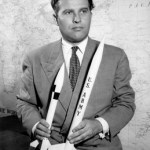
Stanley Kubrick’s 1964 dark satire Dr Strangelove is a classic of the genre which comically probes the collective anxieties triggered in the West by the Cold War at its height in the early 1960s. Kubrick hammers home the utter absurdity of the prevailing nuclear standoff between the US and the Soviet Union and the consequential existential threat to the planet from the doctrine of Mutually Assured Destruction (MAD) and “Doomsday bombs”. The movie’s plot involves the unilateral unleashing of a preemptive strike on Moscow by a deranged US Air Force general and the Pentagon’s shoddy attempts at “management” of the crisis.

Sellers as Dr Strangelove
˚
Kubrick and his film co-writers Terry Southern and Peter George give us three dangerously over-the-top, lunatic fringe characters – two gung-ho hawkish military types, generals Turgidson and Ripper, and the eponymous “Dr Strangelove”𝟙. The central figure in the nuclear nightmare scenario, Dr Strangelove (played by Peter Sellers), is a former German Nazi technocrat turned US strategic weapons expert and scientific advisor to the US president Merkin Muffley (also Sellers). Strangelove is creepily sanguine about the prospect for humanity post-nuclear Holocaust, expanding on his vision of a 100-year plan for survival (for some)…a male elite ensconced in an underground bunker where they can sire a selective breeding program with a plurality of desirable females [‘Dr Strangelove (character)’, Kubrick Wiki, www.kubrick.fandom.com].
 Wernher Von Braun (Photo: Mondadori via Getty Images)
Wernher Von Braun (Photo: Mondadori via Getty Images)˚
Strangelove a composite of various personages
Though characterised by caricature and satire, the film’s three wildest characters are recognisable among the actual political, military and scientific figures of the day in America. The heavy Middle European accent of Dr Strangelove, his authoritarian-Nazi mannerisms and regular references to “Mein Führer”, has led some observers to conclude that the character was based on German aerospace engineer Wernher von Braun, instrumental in the Nazis’ V-2 rocket project and after 1945 in the US designing space rockets for NASA (a view given countenance by one of the screenwriters Terry Southern). Others have added émigré Hungarian scientists John von Neumann and Edward Teller as models for Strangelove. Both men worked on the Super-bomb projects (A-Bomb, H-Bomb, C-Bomb) for the US government in the 1940s and 50s, and both were rabidly anti-communist and anti-Russian [P.D. Smith, Doomsday Men (2007)]. Teller in particular shared a number of Strangelove’s traits, eg, volatile nature, Soviet-fixated and obsessed with bombs, possessed of a prosthetic limb. It’s probably a reasonable bet that the there was something of the personality of all three men in Dr Strangelove, but other individuals were also sources of inspiration for the character.
 Herman Kahn (Source: Alchetron)
Herman Kahn (Source: Alchetron)˚
A Megadeath influencer from RAND
Another real-life figure widely associated with the Strangelove character is Herman Kahn, who was a physicist and military strategist with the RAND Corporation𝟚. Kubrick got the idea of a “Doomsday Machine” from Kahn whose 1960 book On Thermonuclear War posited the possibility of a winnable (sic) nuclear war. Kahn has been described as a “Megadeath Intellectual” with his robust insistence that the dangers of nuclear war were exaggerated (this also accords with the outlier position of General Buck Turgidson – see below)𝟛.
 Gen. Jack Ripper (Photo: Columbia Pictures)
Gen. Jack Ripper (Photo: Columbia Pictures)˚
Military madness
Maverick general in the Strategic Air Command Jack D Ripper (played by Sterling Hayden) is gripped by the all-consuming communist conspiracy hysteria. His belief in the loony notion that the Soviets have been fluoridating American water supplies to pollute the “precious bodily fluids” of Americans leads him to initiate a H-Bomb onslaught on the USSR without consulting the Pentagon. Ripper’s wild rhetoric and blustery style has been compared to Robert Welch, the rabid anti-communist founder of the ultra-conservative and reactionary John Birch Society. Ripper’s loopy claim about Soviet water contamination echoes Welch’s baseless anti-fluoridation allegations (‘How I Learned to Stop Worrying’).

Gen. LeMay (Image: Mort Kunstler / Stag)
˚
Expendable dead
Gen. Buck Turgidson (played by George C Scott) was largely modelled on four-star air force general Curtis LeMay𝟜. Turgidson is an unrepentant war hawk who wants to escalate Ripper’s nuclear attack on the Soviets, justifying it with the outrageous claim that it will result in only “limited” casualties from the ensuing superpower war, which in his estimate equates to 10 to 20 million dead! Like Turgidson LeMay danced to the beat of his own drum, he was well disposed towards a preemptive strike on the Russians and vociferously advocated nuclear strikes on Cuba during the Cuban Missile Crisis and on North Vietnam during the Indo-China War.
 Gen. Turgidson (Scott) in the War Room (Columbia Pictures)
Gen. Turgidson (Scott) in the War Room (Columbia Pictures)˚
The actions and statements of the clearly psychotic Ripper and morally reprehensible Turgidson convey insights into the level of paranoia gripping the real-life military commanders in the climate of the nuclear arms buildup in the Sixties. [Fred Kaplin, “Truth Stranger than ‘Strangelove‘“, New York Times, 10-Oct-2004, nytimes.com].
Footnote: Satirical Dr Strangelove v Serious Fail Safe
Intriguingly, at the same time Kubrick was making Dr Strangelove there was a separate film in the works also about an American nuclear attack on the USSR. Fail Safe dealt with the same subject but as a straight-up drama. In this second film about nuclear Armageddon the trigger to the catastrophic event however is not rogue generals but a technical glitch. Strangelove’s equivalent morality-free scientist character in Fail Safe is Professor Groeteschele (played by Walter Matthau) who draws similar comparisons with Herman Kahn.

𝄪𝄪𝄪𝄪𝄪𝄪𝄪𝄪𝄪𝄪𝄪𝄪𝄪𝄪𝄪𝄪𝄪𝄪𝄪𝄪𝄪𝄪𝄪𝄪𝄪𝄪𝄪𝄪𝄪𝄪𝄪𝄪𝄪𝄪𝄪𝄪𝟙
𝟚 mimicked in Dr Strangelove as the BLAND Corporation
𝟛 another Strangelove comparison is Henry Kissinger…suggested by a shared “eerie poise, lugubrious German accent and brutally pragmatic realpolitik” [Gary Susman, ‘Dr. Strangelove or: How I Learned to Stop Worrying and Love the Bomb’, Time, 11-Feb-2013, www.entertainment.time.com]
𝟜 although behaviourally the Ripper character (“cigar-chomping, gruff-talking”) also resembles LeMay’s style






